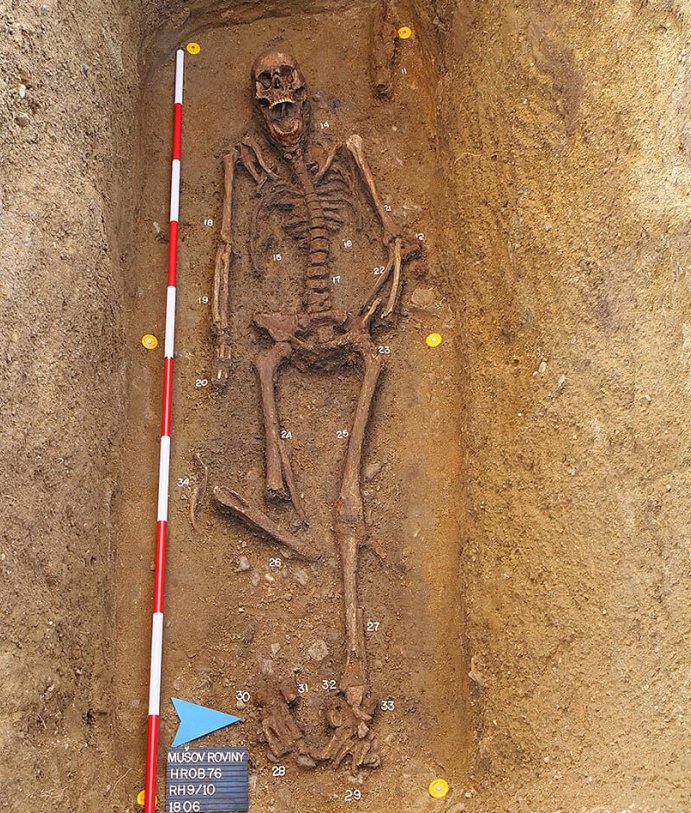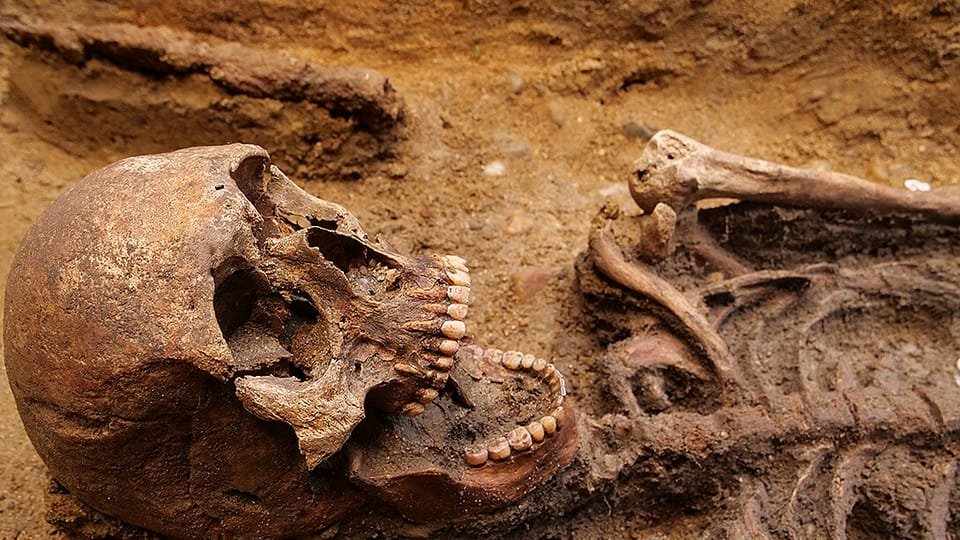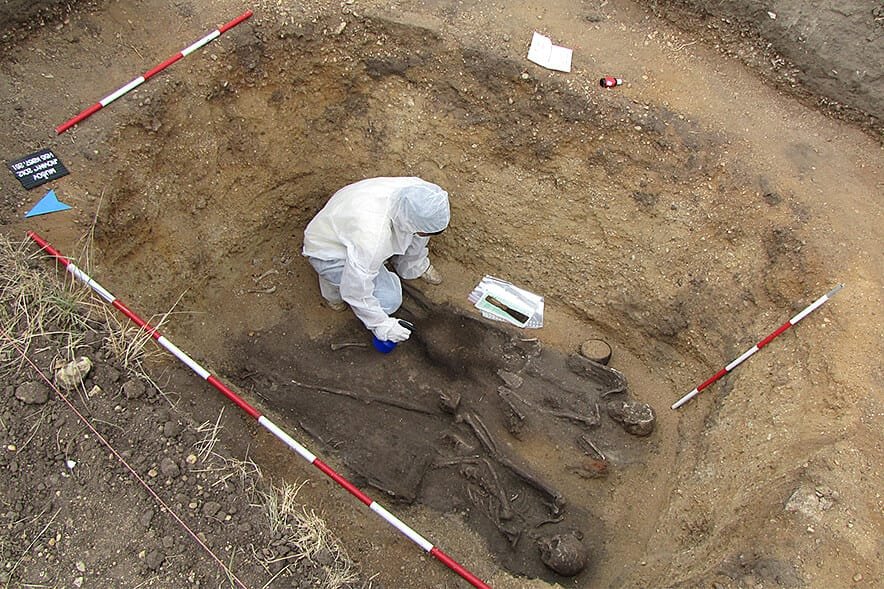Young Warrior’s Grave Dated To A Sixth Century Unearthed At Langobard Necropolis In Czech Republic
Conny Waters - AncientPages.com - An almost intact skeleton of a young warrior has been unearthed during archaeological excavations in the vicinity of Pasohlávky in the Brno-Country District in the South Moravian Region of the Czech Republic.
Germanic Langobard burial site | Photo: Zuzana Loskotová, Archaeological Institute of the Academy of Sciences of the Czech Republic. Photo via Radio Prague International
The grave dated to the sixth century contains a skeleton of the man buried with his spear, two dogs, and a horse bridle. The burial place belongs to one of the country's largest Germanic Langobard burial sites. Located on the southern bank of the Nové Mlýny reservoir, this burial ground is dated to the so-called Migration Period on the territory of the Czech Republic, writes Radio Prague International.
The so-called Migration Period was critical in European history, marked by large migration movements that saw the fall of the Western Roman Empire and subsequent settlement of its former territories by various tribes.
This historically significant period (from 375 AD (possibly as early as 300) to the end of 568 AD, refers to the migration, invasion, and settlement of various tribes, including the Franks, Goths, Alemanni, Alans, Huns, the early Slavs, Pannonian Avars, Magyars, and Bulgars within or into the former Western empire and Eastern Europe.
Image credit: Zuzana Loskotová, Archaeological Institute of the Academy of Sciences of the Czech Republic. Photo via Radio Prague International
Excavations at the Langobard necropolis began in May this year and revealed some 250 graves in the area. Archaeologists use geophysical research and aerial photography, and most probably, the total number of graves at the site is much higher.
According to Zuzana Loskotová from the Brno Institute of Archaeology, which is part of the Czech Academy of Sciences, unfortunately, many graves were already looted during the Migration Period.
The grave of the young warrior, unearthed in the vicinity of the Nové Mlýny reservoir, was found exceptionally well-preserved, giving the researchers a unique opportunity to understand better the Langobard population, including their health and eating habits.
"We are undertaking a number of analyses, including strontium analyses, where we can investigate where the inhabitants came from or whether they are of local origin.
"Then there is carbon and nitrogen isotope analyses that might tell us something about the diet of the inhabitants. We will also carry out paleopathological analyses, which looks at what diseases they had and what injuries they suffered during their lifetime."
Image credit: Zuzana Loskotová, Archaeological Institute of the Academy of Sciences of the Czech Republic. Photo via Radio Prague International
Balász Komoróczy, director of the Brno branch of the Institute of Archaeology, explained that "all of a sudden, new cultural and ethnic groups appear, and large entities move over a considerable territory of Europe. And at the end of this process, sometimes at the end of the 6th century, practically a new world appears, out of which medieval and even modern Europe is being built."
According to Komoróczy, studying the migrating tribes of the era could help shed light on the processes that led to the disappearance of civilizations and the emergence of new cultures. It can also shed light on the possible causes of migration. He says:
"We can examine, for example, whether it was related to climatic conditions. It is a period in which we can examine phenomena that we do not see in stable eras when populations settle in one place for a long period of time."
The current research of Germanic burial sites in Moravia is part of a larger European project called HistoGenes. The project analyses the genetics of Central and Eastern European populations from the 5th to the 8th century and will contribute more important information about life in early medieval Europe.
Earlier, archaeologists discovered another intact grave of a Langobard warrior also dated to the sixth century. The grave was located in a wooden chamber, and the man was buried with a sword, a spear, and a shield. The Langobard warrior, his horse and a dog lay above him.
Further excavations revealed a large burial ground with over a hundred graves. Most of them, however, had been already looted long time ago. The remaining finds from these graves show that the area belonged to a high aristocratic class.
Archaeologists found jewellery such as clasps, buckles and beaded bracelets.
The ancient sources confirm that the Langobards were one of the West Germanic tribes from the lower Elbe. In 568, they conquered northern Italy and founded an empire that existed until the end of the eighth century.
Later Charlemagne conquered the region and established there the Kingdom of Italy. Between the 4th and 5th centuries, the Langobards decided to leave their settlements in the Labe region. They moved south to the Austrian Danube, passing Bohemia and Moravia in the modern Czech Republic on their way.
Written by Conny Waters - AncientPages.com Staff Writer
More From Ancient Pages
-
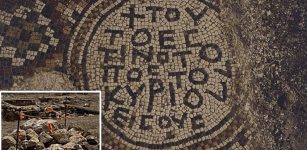 The 6th Century Byzantine Church Hidden Within Khirbet Tinshemet’s Woods – Discovered
Archaeology | Oct 2, 2024
The 6th Century Byzantine Church Hidden Within Khirbet Tinshemet’s Woods – Discovered
Archaeology | Oct 2, 2024 -
 DNA Reveals Stone Age People Avoided Inbreeding
DNA | Mar 9, 2024
DNA Reveals Stone Age People Avoided Inbreeding
DNA | Mar 9, 2024 -
 Re-Writing History Of England’s Domesday Book Of William I The Conqueror
Archaeology | Nov 27, 2018
Re-Writing History Of England’s Domesday Book Of William I The Conqueror
Archaeology | Nov 27, 2018 -
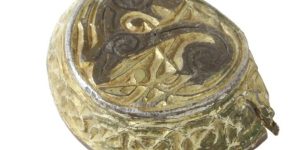 Strange 1,200-Year-Old Anglo-Saxon Artifact Used For Unknown Purpose Found In Norfolk, UK
Archaeology | Jan 18, 2024
Strange 1,200-Year-Old Anglo-Saxon Artifact Used For Unknown Purpose Found In Norfolk, UK
Archaeology | Jan 18, 2024 -
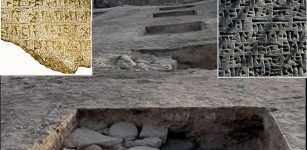 Monumental Structure Unearthed During Excavations Of Urartu-Era Karmir Blur
Archaeology | Nov 25, 2022
Monumental Structure Unearthed During Excavations Of Urartu-Era Karmir Blur
Archaeology | Nov 25, 2022 -
 Roman-Era Girl Buried And Adorned With 1,700-Year Old Gold Jewelry Found In Pagan Cave
Archaeology | Apr 8, 2023
Roman-Era Girl Buried And Adorned With 1,700-Year Old Gold Jewelry Found In Pagan Cave
Archaeology | Apr 8, 2023 -
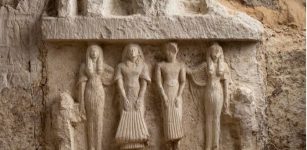 Impressive Ancient Underground Tombs And Chapels Unearthed In Saqqara, Egypt
Archaeology | Apr 16, 2023
Impressive Ancient Underground Tombs And Chapels Unearthed In Saqqara, Egypt
Archaeology | Apr 16, 2023 -
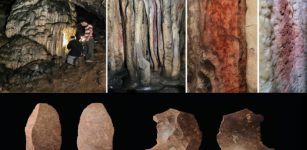 Cueva de Ardales – Rock Art Cave In Spain Was Used By Ancient Humans For More Than 50,000 Years
Archaeology | Jun 1, 2022
Cueva de Ardales – Rock Art Cave In Spain Was Used By Ancient Humans For More Than 50,000 Years
Archaeology | Jun 1, 2022 -
 Stunning Discovery Of 1,000-Year-Old Knight’s Sword From Reign Of Poland’s First King Bolesław The Brave
Archaeology | Jul 28, 2022
Stunning Discovery Of 1,000-Year-Old Knight’s Sword From Reign Of Poland’s First King Bolesław The Brave
Archaeology | Jul 28, 2022 -
 Surprising Evidence Of 12,000-Year-Old Unknown Advanced Secret Knowledge Held By Elite Individuals – The Connection – Part 2
Ancient Mysteries | Feb 7, 2021
Surprising Evidence Of 12,000-Year-Old Unknown Advanced Secret Knowledge Held By Elite Individuals – The Connection – Part 2
Ancient Mysteries | Feb 7, 2021 -
 Oldest Indo-European Calendar Based On The Orion Constellation Is Engraved On A Vucedol Vessel
Artifacts | Jun 7, 2021
Oldest Indo-European Calendar Based On The Orion Constellation Is Engraved On A Vucedol Vessel
Artifacts | Jun 7, 2021 -
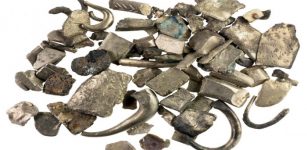 Hacksilber Hoard Dated To 11th Century BC: Eastern Mediterranean Silver Trade Reconstructed
Archaeology | Jul 5, 2021
Hacksilber Hoard Dated To 11th Century BC: Eastern Mediterranean Silver Trade Reconstructed
Archaeology | Jul 5, 2021 -
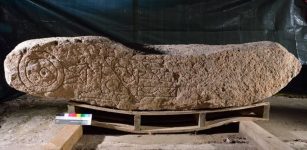 Dandaleith Stone: Scotland’s Rare Symbol Stone Of The Picts – Will It Be Deciphered Now?
Ancient Symbols | Jan 21, 2016
Dandaleith Stone: Scotland’s Rare Symbol Stone Of The Picts – Will It Be Deciphered Now?
Ancient Symbols | Jan 21, 2016 -
 Groundbreaking Study: First Known Case Of Down Syndrome In Neanderthals – Investigated
Archaeology | Jun 28, 2024
Groundbreaking Study: First Known Case Of Down Syndrome In Neanderthals – Investigated
Archaeology | Jun 28, 2024 -
 Missing ‘Delmenhorst’: 17th Century Danish Warship From ‘Battle Of Fehmarn’ Found
Archaeology | Sep 22, 2020
Missing ‘Delmenhorst’: 17th Century Danish Warship From ‘Battle Of Fehmarn’ Found
Archaeology | Sep 22, 2020 -
 Vercingetorix: Greatest Of All Gallic Leaders And Hero Of The French People
Featured Stories | Jun 24, 2020
Vercingetorix: Greatest Of All Gallic Leaders And Hero Of The French People
Featured Stories | Jun 24, 2020 -
 Unusually Arranged Skeletons And Artifacts Found Inside A 1,500-Year-Old Tomb In Berenice Troglodytica, Egypt
News | May 27, 2022
Unusually Arranged Skeletons And Artifacts Found Inside A 1,500-Year-Old Tomb In Berenice Troglodytica, Egypt
News | May 27, 2022 -
 ‘Armenian Stonehenge’: 30 Unknown Stones In Carahunge Complex – Surveyed
Archaeology | Aug 12, 2020
‘Armenian Stonehenge’: 30 Unknown Stones In Carahunge Complex – Surveyed
Archaeology | Aug 12, 2020 -
 Sacrificial Remains From The Iron Age Unearthed Near Aarhus, Denmark
Archaeology | Oct 14, 2015
Sacrificial Remains From The Iron Age Unearthed Near Aarhus, Denmark
Archaeology | Oct 14, 2015 -
 Hopi’s Encounter With Maasaw – The Skeleton Man And His Gift Of Sacred Knowledge
Myths & Legends | May 5, 2017
Hopi’s Encounter With Maasaw – The Skeleton Man And His Gift Of Sacred Knowledge
Myths & Legends | May 5, 2017

